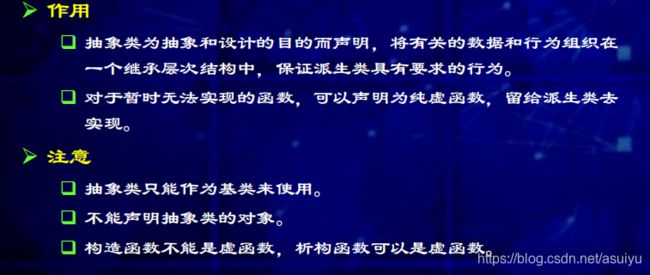C++模块总结
实现运算符重载
运算符重载是对已有运算符赋予多重含义

操作符重载的两种形式


要注意的是:
进行指针相等操作时,可能发生内存泄露;因为指针a=b,给a赋予b的值,相当于将a所指向地址改成b所指向地址,而a原来所指向地址发生丢失。


拷贝构造函数
对于包含动态分配成员或者包含指针成员的类都应该提供拷贝构造函数;
在提供拷贝构造函数时,应考虑重载“=”赋值操作符号。
派生类
1.构造函数
2.析构函数
- 执行派生类析构函数的函数体
- 对派生类新增的类类型的成员对象进行清理,即调用类类型的派生类对象成员所在类的析构函数
- 对所有从基类继承来的成员进行清理,即调用基类析构函数
析构函数
-
析构函数在对象的生存期即将结束的时刻被自动调用;
-
没有返回值;不接受任何参数;
-
如果不进行显式说明,系统将自动生成一个函数体为空的隐含析构函数。
-
一般来说,如果希望程序在对象被删除之前自动完成某些事情,可以将其写到析构函数中。
#include运行结果如下

说明了可以在不同派生类对象中定义名称相同、功能不同的虚函数(虚函数在基类中有声明)
虚函数
1.一般虚函数成员
虚函数声明只能出现在类定义中的函数原型声明中,而不能在成员函数实现时
运行过程中的多态需要满足的3个条件:
赋值兼容规则
声明虚函数
由成员函数来调用或者通过指针、引用来访问虚函数
虚函数一般不声明为内联函数,因为对虚函数的调用需要动态绑定,而内联函数的处理是静态的
派生类的虚函数会覆盖基类的虚函数
2.虚析构函数
C++不可以声明虚构造函数,但可以声明虚析构函数
如下是未使用虚析构函数的程序
#include运行时输出结果为:
Base destructor
这说明,通过基类指针删除派生类对象时调用的是基类的析构函数,派生类的析构函数未被执行,因此派生类对象中动态分配的内存空间没有得到释放,造成内存泄露;对于内存需求量较大,长期连续运行的程序来说,持续发生这样的错误是危险的,最终会因内存不足引起程序终止。
修正方法
class Base{
public:
virtual ~Base();
}
这时运行输出信息为
Derived destructor
Base destructor
说明派生类对象中动态申请的内存空间被正确释放,这是由于使用了虚析构函数,实现了多态。
3.纯虚函数和抽象类
纯虚函数
virtual 函数类型 函数名(参数表)=0;
//声明为纯虚函数之后,基类中可以不再给出函数的实现部分。
//纯虚函数的函数体由派生类给出
#include运行结果如下

说明了可以在不同派生类对象中定义名称相同、功能不同的虚函数(虚函数在基类中有声明)
#include运行结果如下

说明了可以在不同派生类对象中定义名称相同、功能不同的虚函数(虚函数在基类中有声明)
运行栈与函数调用的执行
函数的形参和局部变量,可以用栈来存储,叫做运行栈;后进先出;
运行栈中的数据分为一个一个的栈帧,每个栈帧对应一次函数调用,包括这次函数调用时的形参值、局部变量值、临时数据等。
内联函数
函数调用需要消耗一定内存资源和运行时间来传递参数和返回值,要记录调用时的状态,以便保证调用完成后能够正确地返回并继续运行;如果有的函数成员需要被频繁调用,而且代码比较简单,可以被定义为内联函数。
隐式声明;
显式声明:
inline void Clock::showTime()
联合体:
联合体的各个对象成员,不能有自定义的构造函数、自定义的析构函数和重载的赋值赋值运算符;
联合体不能继承,不支持多态;
线性群体
操作数栈 ODS
操作符栈 OPS
1.浅复制与深复制
int main()
{
Array <int> a(10);
...
Array <int> b(a);
//如上浅复制,只是将对象a中数组元素地址简单赋值给对象b的指针成员,没有复制数组元素,对象b没有构造自己的数组。结果是a和b共同使用同一段内存空间存放数组元素,这样会造成混乱。
Array类的应用
求范围2~n中的质数,n在程序运行时由键盘输入
#include栈的应用----- 一个简单的整数计算器
主要思想:每当遇到操作数,便入栈;遇到操作符,便连续弹出两个操作数并执行运算,并将运算结果压入栈顶。输入“c”时,清空操作数栈;输入“q”时,清空操作数栈并结束程序
//Calculator.h
#ifdef CALCULATOR_H
#define CALCULATOR_H
#include"Stack.h"
class Calculator{
private:
Stack<double>s; //操作数栈
void enter(double num); //将num压入栈
bool getTwoOperands(double &opnd1,double &opnd2);
void compute(char op);
public:
void run();
void clear();
};
#endif
//Calculator.cpp
#include"Calcluator.h"
#includeSTL(standard template library) C++标准模板库
1.容器(7种)
顺序容器:向量,双端队列,列表容器
关联容器:集合,多重集合,映射,多重映射
#include#include结果如下
1 2 -3 4 5
-1 -2 3 -4 -5



